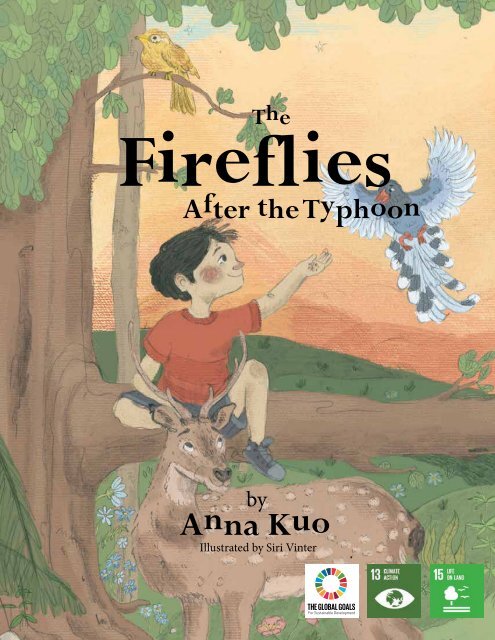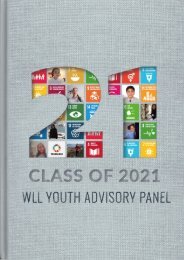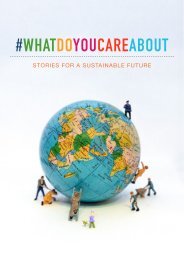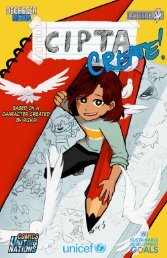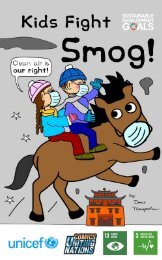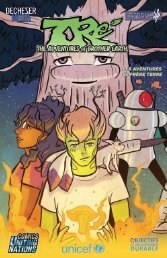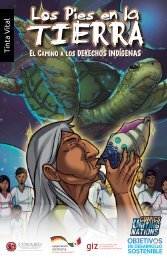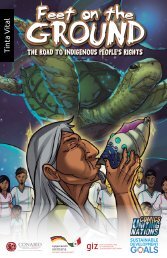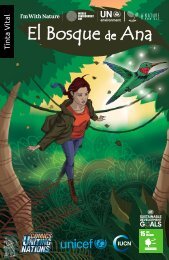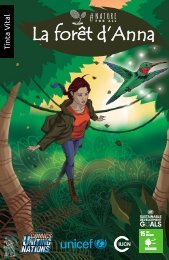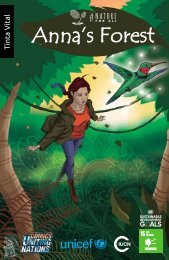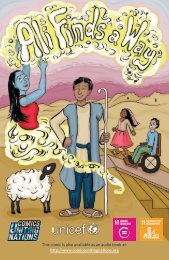The Fireflies After the Typhoon
You also want an ePaper? Increase the reach of your titles
YUMPU automatically turns print PDFs into web optimized ePapers that Google loves.
<strong>The</strong><br />
<strong>Fireflies</strong><br />
<strong>After</strong> <strong>the</strong> <strong>Typhoon</strong><br />
by<br />
Anna Kuo<br />
Illustrated by Siri Vinter
Published and distributed by:<br />
Voices of Future Generations International Children’s Book Series<br />
Trust for Sustainable Living<br />
Hampstead Norreys, Berkshire, RG18 0TN, United Kingdom<br />
Tel: +44 (0)1635 202444<br />
Web: www.vofg.org<br />
Special thanks to René V. Steiner for layout and graphics support:<br />
www.steinergraphics.com.<br />
Text © Anna Kuo 2017<br />
Illustrations © Siri Vinter 2017<br />
<strong>The</strong> Voices of Future Generations International Children’s Book Series:<br />
‘<strong>The</strong> Epic Eco-Inventions’ by Jona David (Europe/North America), illustrated by Carol Adlam<br />
‘<strong>The</strong> Great Green Vine Invention’ by Jona David (Europe/North America), illustrated by Carol Adlam<br />
‘<strong>The</strong> Tree of Hope’ by Kehkashan Basu (Middle East), illustrated by Karen Webb-Meek<br />
‘<strong>The</strong> <strong>Fireflies</strong> <strong>After</strong> <strong>the</strong> <strong>Typhoon</strong>’ by Anna Kuo (Asia), illustrated by Siri Vinter<br />
‘<strong>The</strong> Species-Saving Time Team’ by Lautaro Real (Latin America), illustrated by Dan Ungureanu<br />
‘<strong>The</strong> Sisters’ Mind Connection’ by Allison Lievano-Gomez (Latin America), illustrated by Oscar Pinto<br />
‘<strong>The</strong> Forward and Backward City’ by Diwa Boateng (Africa), illustrated by Meryl Treatner<br />
‘<strong>The</strong> Voice of an Island’ by Lupe Vaai (Pacific Islands), illustrated by Li-Wen Chu<br />
‘<strong>The</strong> Visible Girls’ by Tyronah Sioni (Pacific Islands), illustrated by Kasia Nieżywińska<br />
‘<strong>The</strong> Mechanical Chess Invention’ by Jona David (Europe/North America), illustrated by Dan Ungureanu<br />
CISDL<br />
Centre for International<br />
Sustainable Development Law<br />
This book is printed on recycled paper, using sustainable and low-carbon printing methods.
<strong>The</strong><br />
<strong>Fireflies</strong><br />
<strong>After</strong> <strong>the</strong> <strong>Typhoon</strong><br />
by<br />
Anna Kuo<br />
Illustrated by Siri Vinter<br />
3
4
foreword<br />
<strong>The</strong> Environmental Quality Protection Foundation was<br />
established in 1984 as <strong>the</strong> premier non-profit organisation<br />
focusing on major global environmental issues based in Taiwan.<br />
Our main tasks include tree planting, environmental education<br />
and international participation. Novelty and non-obvious<br />
approaches are <strong>the</strong> core of our initiatives and programmes.<br />
<strong>The</strong> next generation leads <strong>the</strong> future we want. In <strong>the</strong> climate<br />
change era, we will have difficulties adapting without reopening<br />
our minds. I am so glad to take part in <strong>the</strong> Voices of Future<br />
Generations book series to promote <strong>the</strong> <strong>the</strong> UN Convention on <strong>the</strong> Rights of <strong>the</strong> Child<br />
for its 25th anniversary and <strong>the</strong> UN Sustainable Development Goals. In all <strong>the</strong> desperate,<br />
deep thinking, optimistic, and creative stories we obtained from all over <strong>the</strong> world, we see<br />
that children are telling <strong>the</strong> most important stories for Mo<strong>the</strong>r Earth and <strong>the</strong> people whose<br />
lives rely on her.<br />
Ying-Shih Hsieh<br />
Chairman, Environmental Quality Protection Foundation, Taiwan<br />
5
6
preface<br />
<strong>Typhoon</strong>s and earthquakes are real life experience in<br />
Taiwan, <strong>the</strong> beautiful formosa. To brea<strong>the</strong> simultaneously<br />
with typhoons and earthquakes is <strong>the</strong> ultimate homework<br />
for Taiwanese people. This book, <strong>Fireflies</strong> <strong>After</strong> <strong>the</strong> <strong>Typhoon</strong>,<br />
speaks of exactly that dependency relationship between people<br />
and <strong>the</strong> natural environment. Listening deeply to <strong>the</strong> voices<br />
and opinions of our children on <strong>the</strong> Sustainable Development<br />
Goals is crucial. All humans are tenants of <strong>the</strong> natural world —<br />
none have <strong>the</strong> right to dominate Mo<strong>the</strong>r Earth. <strong>The</strong> Voices of<br />
Future Generations Children’s Book Series provides a chance<br />
for adults to listen carefully to <strong>the</strong> voices from our future generations and respect <strong>the</strong><br />
rights of children to speak for <strong>the</strong> Earth.<br />
Hui-Chien Ku<br />
Assistant Professor of <strong>the</strong> Department of Applied Chinese at Ming Chuan University and<br />
United Daily News Column Writer<br />
7
chapter<br />
1<br />
8
On top of a small hill, in <strong>the</strong> mountains on <strong>the</strong> island of Formosa, lies <strong>the</strong><br />
beautiful Peach Blossom Village. Rare animals roamed <strong>the</strong> hills of <strong>the</strong> village.<br />
Macaques swung from one tree to ano<strong>the</strong>r, Formosan sika deer showed <strong>the</strong>ir<br />
pretty spots, Mikado pheasants made special ‘ke ke ke’ calls, Taiwanese Hwamei<br />
Laughingthrush birds flew with startled eyebrows, and squirrels and rabbits also<br />
ran about. <strong>The</strong>y were happy in <strong>the</strong>ir forest habitats around <strong>the</strong> village. Flowers<br />
and trees blossomed everywhere and Anodendron vines bloomed beautiful<br />
white flowers every spring.<br />
9
<strong>The</strong> villagers had peaceful lives in harmony with <strong>the</strong>ir<br />
surroundings. <strong>The</strong> children, especially, spent a lot of<br />
time in <strong>the</strong> forests – it was <strong>the</strong>ir playground, <strong>the</strong>ir<br />
school and <strong>the</strong>ir forage grounds. <strong>The</strong>y often ga<strong>the</strong>red<br />
nuts, fruits and mushrooms to give to <strong>the</strong>ir families<br />
and to share with neighbours.<br />
10
<strong>The</strong>y loved to watch in <strong>the</strong> evenings, as <strong>the</strong> fireflies<br />
danced among <strong>the</strong> trees, <strong>the</strong>ir little lanterns lighting<br />
<strong>the</strong> deep, dark green of <strong>the</strong> forest shadows with<br />
cheerful signals of life and love.<br />
11
A boy named Tongyan grew up in this green, lively<br />
environment. He was a respectful and quiet boy,<br />
curious and interested in everything that grew, but<br />
often solemn. He usually got along with everyone<br />
at school because he did not argue, but he felt<br />
happiest in <strong>the</strong> forest.<br />
12
Every day, after school, he would explore <strong>the</strong> woods<br />
and streams with his friends, observing <strong>the</strong> life<br />
cycles of all <strong>the</strong> special animals and plants living<br />
in balance with each o<strong>the</strong>r and <strong>the</strong>ir surroundings.<br />
All seemed well until one fateful day...<br />
13
chapter<br />
2<br />
At first, it seemed just like any o<strong>the</strong>r week. Tongyan had finished school and<br />
was thinking about whe<strong>the</strong>r to catch a caterpillar for his nature studies or to<br />
play a game of ‘beggar ticks’ with his classmates, after doing his homework.<br />
As he walked home, Tongyan suddenly noticed many workers moving quickly<br />
through <strong>the</strong> forest, clearing <strong>the</strong> large and shady trees that once stood tall and<br />
proud. <strong>The</strong> cut raw logs were being loaded onto trucks and driven away.<br />
This was a horrifying sight for Tongyan. “Why are <strong>the</strong>y cutting down all our<br />
special trees? Where will <strong>the</strong> animals and insects live if this happens?” Tongyan<br />
asked himself in shock.<br />
14
15
When he arrived home, he found his parents<br />
discussing important matters in low, serious<br />
voices at <strong>the</strong> low table on <strong>the</strong>ir verandah. Tongyan<br />
wanted to ask what <strong>the</strong>y were talking about and<br />
approached <strong>the</strong>m respectfully. Before he could<br />
even raise his question, his parents turned to him.<br />
“Go do your homework quietly. We have to tell you<br />
something serious, after dinner,” <strong>the</strong>y ordered.<br />
16
Tongyan did not understand why he was being<br />
sent away and why his parents were so secretive.<br />
However, he was a good boy and knew not to let<br />
curiosity get <strong>the</strong> better of him. He went to his<br />
room to work on his maths, science and Chinese<br />
studies, as he had been told.<br />
17
<strong>After</strong> dinner, Tongyan sat with his family in <strong>the</strong><br />
living room and <strong>the</strong>y stared at each o<strong>the</strong>r without<br />
a word. His parents had a solemn, serious look on<br />
<strong>the</strong>ir faces. It was his fa<strong>the</strong>r who broke <strong>the</strong> spell<br />
of silence. He said, “You must have noticed many<br />
men, cutting down all of our village forests as you<br />
walked home today.” Tongyan nodded.<br />
His fa<strong>the</strong>r also said, “<strong>The</strong>y have now resolved to<br />
plant <strong>the</strong>se betel palms. <strong>The</strong> village elders have<br />
held a long discussion about this, over <strong>the</strong> last few<br />
weeks. We all have money problems in this village<br />
and <strong>the</strong>y want better lives for ourselves and our<br />
families.<br />
18
19
This may mean that you cannot play outside in<br />
nature with your friends like you used to in <strong>the</strong><br />
woods, but so long as we take good care of those<br />
betel palms, <strong>the</strong>y say, we will be able to make more<br />
money and buy many things for ourselves.”<br />
20
Tongyan was a respectful boy. He did not argue or<br />
say anything. Deep inside, he was sad and confused<br />
by <strong>the</strong> decision. He could not understand why<br />
some village men had decided to harm and take<br />
away his wildlife friends, his playground, and his<br />
discoveries, just for <strong>the</strong> sake of being able to buy<br />
more things.<br />
21
chapter<br />
3<br />
Three years passed and <strong>the</strong> children watched as<br />
<strong>the</strong> diverse wildlife of Peach Blossom Village was<br />
almost completely replaced by a productive, and<br />
industrial, monoculture of straight and stiff betel<br />
palms. <strong>The</strong> palms stuck out of <strong>the</strong> primly tended<br />
soil like rows of spiky toothbrushes.<br />
22
<strong>The</strong> village adults had new jobs, working in <strong>the</strong><br />
plantations and keeping everything growing in<br />
straight rows, also harvesting <strong>the</strong> betel palms.<br />
Betel palms produce betel nuts. Some say that betel<br />
nuts can protect your body and keep your spirits<br />
up, so many folks eat <strong>the</strong>m. That’s why planting<br />
betel palms can make a lot of money.<br />
23
Unfortunately, Tongyan and <strong>the</strong> people of <strong>the</strong><br />
village could no longer hear <strong>the</strong> birds singing in<br />
spring, could no longer smell <strong>the</strong> fragrance of<br />
blooming flowers and could no longer see children<br />
dashing off to play and make hideouts in <strong>the</strong><br />
forests. Children mainly stayed indoors, watching<br />
<strong>the</strong>ir new televisions or playing video games.<br />
24
<strong>The</strong> streams were fierce yet sullen, carrying<br />
chemicals for growing palms away from <strong>the</strong> village<br />
and over <strong>the</strong> rocks. People had begun to worry<br />
about whe<strong>the</strong>r <strong>the</strong>y could drink <strong>the</strong> water. Some<br />
neighbours living downstream even complained<br />
of ill-health. Some of <strong>the</strong> children were very sad.<br />
<strong>The</strong>ir hideouts were felled or forbidden.<br />
25
<strong>The</strong>y ga<strong>the</strong>red in corners at school and spoke in<br />
quiet voices about <strong>the</strong> loss of <strong>the</strong>ir forests, about <strong>the</strong><br />
unfairness of <strong>the</strong> choice that had been made without<br />
<strong>the</strong>ir views being heard. <strong>The</strong>y missed <strong>the</strong>ir forest<br />
friends, especially <strong>the</strong> dancing lights of <strong>the</strong> fireflies<br />
at dusk.<br />
26
<strong>The</strong> typhoons and heavy rains became worse<br />
each year. Since <strong>the</strong> typhoon season began, many<br />
trees had fallen over, obstructing <strong>the</strong> once simple<br />
mountain paths and destroying <strong>the</strong> roads that<br />
people needed. Ano<strong>the</strong>r major typhoon began<br />
approaching. <strong>The</strong> village elders heard <strong>the</strong> early<br />
warning alerts and knew that people could not<br />
simply stay in <strong>the</strong>ir homes when <strong>the</strong>y are right in<br />
<strong>the</strong> path of such a serious typhoon.<br />
27
At first, <strong>the</strong>y were grateful for <strong>the</strong> new televisions<br />
and radios which gave <strong>the</strong>m warnings and updates<br />
about <strong>the</strong> storm as it was tracked. <strong>The</strong>y were all<br />
advised to evacuate to emergency shelters at <strong>the</strong><br />
foot of <strong>the</strong> mountain before <strong>the</strong> typhoon arrived.<br />
As was explained — <strong>the</strong>re would always be time<br />
for plans once <strong>the</strong> typhoon had passed overhead.<br />
Tongyan and his parents packed as many of <strong>the</strong>ir<br />
belongings as <strong>the</strong>y could and <strong>the</strong>n travelled down<br />
to <strong>the</strong> shelter. <strong>The</strong>y were careful and arrived in<br />
good time, before <strong>the</strong> storm became worse.<br />
28
<strong>The</strong> gloom of <strong>the</strong> storm clouds was heavy all<br />
afternoon. Soon <strong>the</strong> mighty typhoon could be seen<br />
travelling towards <strong>the</strong>m all, speeding across <strong>the</strong> sky.<br />
<strong>The</strong> force of <strong>the</strong> typhoon struck hardest at night. Its<br />
powerful winds and downpours destroyed every<br />
road connecting <strong>the</strong> little community to <strong>the</strong> rest<br />
of <strong>the</strong> island. <strong>The</strong> vegetation covering <strong>the</strong> earth<br />
was ripped away mercilessly.<br />
29
Villagers hiding in <strong>the</strong> shelter looked at each o<strong>the</strong>r,<br />
knowing that <strong>the</strong>ir homes, property, <strong>the</strong> things<br />
<strong>the</strong>y had bought with <strong>the</strong> betel money and all that<br />
<strong>the</strong>y had worked to build might be broken up or<br />
blown away.<br />
30
But this was not <strong>the</strong> worst to happen. All <strong>the</strong> people<br />
of <strong>the</strong> island had expected to get back to <strong>the</strong>ir lives,<br />
once <strong>the</strong> typhoon left, having blown over on its way<br />
past <strong>the</strong>m to China. No one foresaw <strong>the</strong> serious<br />
landslide that was to come right afterwards.<br />
31
A torrent of roaring mud, gravel and stone swept<br />
down through <strong>the</strong> village, bringing many giant<br />
boulders that crushed everything in <strong>the</strong>ir path.<br />
<strong>The</strong>re was nothing <strong>the</strong> villagers could do against <strong>the</strong><br />
force of nature. <strong>The</strong>y could only look on helplessly<br />
from <strong>the</strong>ir tiny shelter, as <strong>the</strong> boulders rolled over<br />
<strong>the</strong>ir houses like a mass of angry, stampeding<br />
animals. <strong>The</strong> noise of destruction shook <strong>the</strong>m to<br />
<strong>the</strong>ir very souls.<br />
32
<strong>The</strong> Peach Blossom Village suffered from <strong>the</strong> typhoon’s destruction. A<br />
devastating landscape greeted <strong>the</strong> refugees leaving <strong>the</strong> shelter. Homes,<br />
fields, <strong>the</strong>ir new clinic, <strong>the</strong>ir old school and <strong>the</strong>ir traditional community<br />
centre were completely buried beneath mud and debris. No one could see<br />
any hope for <strong>the</strong>ir future. Tongyan and all <strong>the</strong> children were angry and<br />
very worried. <strong>The</strong>y felt powerless and lost. What could <strong>the</strong>y do to rebuild<br />
<strong>the</strong>ir homes? How could <strong>the</strong>y find a new future?<br />
33
chapter<br />
4<br />
<strong>The</strong> entire village, including<br />
<strong>the</strong> elders, <strong>the</strong> parents and <strong>the</strong><br />
children, felt dusty, sad and tired.<br />
Tongyan ran out to <strong>the</strong> big stone<br />
that stood where <strong>the</strong> school had<br />
once been and found his friends<br />
also waiting <strong>the</strong>re. <strong>The</strong> children<br />
talked and talked.<br />
34
<strong>The</strong>y believed that <strong>the</strong> terrible impacts of <strong>the</strong><br />
disaster were a result of planting <strong>the</strong> betel palms.<br />
“Our teachers explained that in <strong>the</strong> UN Convention<br />
on <strong>the</strong> Rights of <strong>the</strong> Child,” Tongyan said slowly,<br />
“everyone recognises that we have a right to<br />
education about nature and that this right should<br />
be respected.”<br />
35
An older child added, “This is how we know that <strong>the</strong> decision of our village<br />
council, three years ago, taken without thinking about <strong>the</strong> future, has<br />
brought about terrible things.” <strong>The</strong>y remembered that <strong>the</strong>y had learned in<br />
school about palm trees shallow root systems, which were poorly adapted<br />
to holding <strong>the</strong> soil toge<strong>the</strong>r. “<strong>The</strong>re’s no way those toothbrushes could hold<br />
up against <strong>the</strong> landslides,” said ano<strong>the</strong>r child.<br />
36
Tongyan <strong>the</strong>n began to wonder out loud, “In <strong>the</strong><br />
same Convention, it says that we have a right to<br />
a clean environment and that our needs should<br />
be taken into account when adults make choices<br />
for us. I am not so sure <strong>the</strong>se two rights have<br />
been respected.” He added, “Our parents, even us<br />
children, knew that <strong>the</strong> decision of <strong>the</strong> elders was<br />
not right. But we did not ask questions and we kept<br />
quiet. We must help out and find a good way to<br />
share our views.” <strong>The</strong> children resolved, toge<strong>the</strong>r,<br />
to make a change in <strong>the</strong> way of doing things. <strong>The</strong>y<br />
wanted to be a part of decision-making and <strong>the</strong>y<br />
needed <strong>the</strong>ir voices to be heard.<br />
37
Tongyan spoke seriously to his parents: “In our eyes, planting all those<br />
betel palms for money has led to many terrible losses. It has destroyed our<br />
wonderful forests and our friends, as well as everything that we built and<br />
bought. If only we had planned for <strong>the</strong> future ra<strong>the</strong>r than cutting down so<br />
much, so fast, maybe we would not face this disaster today.”<br />
38
Tongyan’s parents listened and <strong>the</strong>n spoke to <strong>the</strong>ir<br />
fellow villagers. <strong>The</strong> older men who had made<br />
decisions alone were worried. <strong>The</strong>y reflected<br />
upon <strong>the</strong> parents and <strong>the</strong> children’s words. <strong>The</strong>y<br />
agreed that <strong>the</strong>ir decision to grow betel palms was<br />
a very bad choice. Everyone decided to correct<br />
this mistake and work toge<strong>the</strong>r to rebuild Peach<br />
Blossom Village so that it could develop sustainably.<br />
39
chapter<br />
5<br />
Happy voices rang out and visitors wandered towards<br />
<strong>the</strong> new village centre, where <strong>the</strong> school and playground<br />
had been rebuilt. “<strong>The</strong>se colourful flower beds and<br />
climbing vines are amazing!” said one visitor. “We<br />
can’t even tell that this village has been restored after<br />
a disaster!” replied ano<strong>the</strong>r. “Hush! Are those <strong>the</strong> rare<br />
Swinhoe’s pheasant and Taiwan blue magpie?” called<br />
ano<strong>the</strong>r, as she stepped off a forest canopy trail.<br />
40
41
This beautiful village with many visitors was <strong>the</strong><br />
reconstructed Peach Blossom Village. <strong>The</strong> villagers<br />
had decided to replant native trees and plants that<br />
were beneficial to <strong>the</strong>ir local environment. <strong>The</strong>y<br />
had dedicated <strong>the</strong>mselves to restoration, so that<br />
<strong>the</strong> animals that once lived around <strong>the</strong>ir village<br />
could return to <strong>the</strong>ir homes.<br />
42
<strong>The</strong>y grew colourful hanging gardens and invited<br />
eco-tourists to stay with <strong>the</strong>m in order to see rare<br />
species and to learn Chinese. <strong>The</strong> villagers also<br />
held special races and festivals according to <strong>the</strong>ir<br />
old traditions. Students from many lands came to<br />
visit and to help. Everyone kept <strong>the</strong> grave lesson<br />
about harming an ecosystem in <strong>the</strong>ir hearts and<br />
agreed to care for <strong>the</strong>ir environment toge<strong>the</strong>r,<br />
working towards <strong>the</strong> future <strong>the</strong>y wanted.<br />
43
Tongyan and <strong>the</strong> o<strong>the</strong>r children had become a<br />
part of <strong>the</strong> process in a children’s council. <strong>The</strong>y<br />
helped as <strong>the</strong>y could, giving <strong>the</strong>ir ideas and a<br />
new point of view. <strong>The</strong>y even made a new special<br />
hideout in <strong>the</strong> forest and nicknamed it “Paradise<br />
of New Hope.”<br />
44
<strong>The</strong>y ga<strong>the</strong>red just before dusk and, when <strong>the</strong>ir<br />
parents called from <strong>the</strong> verandas, <strong>the</strong>y walked back<br />
slowly towards <strong>the</strong>ir homes, trailing <strong>the</strong>ir fingers<br />
backwards among <strong>the</strong> leaves. On arriving home,<br />
Tongyan said, “Look, Mo<strong>the</strong>r! Our forest fireflies<br />
are back, dancing and blinking in <strong>the</strong> dark!”<br />
45
about<br />
<strong>the</strong><br />
author<br />
Anna Kuo (11) lives in Taipei City, and studies in <strong>the</strong> Ying Chiao elementary school.<br />
She is a citizen of <strong>the</strong> Republic of China. She enjoys reading, swimming and travelling<br />
and also likes to learn languages, write and research.<br />
In <strong>the</strong> future, she wants to be a doctor and a writer. She hopes that with this story, she<br />
can express <strong>the</strong> ideas of cherishing resources, caring for our environment, creating<br />
world peace, and helping future generations have a more sustainable, better world.<br />
She thanks her family and friends and her teachers, especially her outstanding<br />
Chinese teacher Chang Man Chuan( 張 曼 娟 ) her English teacher Emily Tsao<br />
( 曹 依 琳 ). She also thanks Mr. Jen Hua Pin( 任 華 斌 ) for his excellent drawings.
about<br />
<strong>the</strong><br />
illustrator<br />
Siri Vinter comes from Norway where <strong>the</strong> winters are white, <strong>the</strong> forests have<br />
trolls and <strong>the</strong> Nor<strong>the</strong>rn lights dance across <strong>the</strong> sky. During her MA in Children’s<br />
Book Illustration at Cambridge School of Art, she discovered her love for creating<br />
illustrations with a screen-printed feel, reminiscent of <strong>the</strong> 1960s. She is inspired by<br />
nature, cluttered rooms, folklore and atmospheric movies.
<strong>The</strong> United Nations Convention on <strong>the</strong> Rights of <strong>the</strong> Child<br />
All children are holders of important human rights. Twenty-five years<br />
ago in 1989, over a hundred countries agreed a UN Convention on<br />
<strong>the</strong> Rights of <strong>the</strong> Child. In <strong>the</strong> most important human rights treaty<br />
in history, <strong>the</strong>y promised to protect and promote all children’s equal<br />
rights, which are connected and equally important.<br />
In <strong>the</strong> 54 Articles of <strong>the</strong> Convention, countries make solemn promises<br />
to defend children’s needs and dreams. <strong>The</strong>y recognize <strong>the</strong> role of<br />
children in realizing <strong>the</strong>ir rights, being heard and involved in decisions.<br />
Especially, Article 24 and Article 27 defend children’s rights to safe<br />
drinking water, good food, a clean and safe environment, health, quality<br />
of life. And Article 29 recognizes children’s rights to education that<br />
develops personality, talents and potential, respecting human rights<br />
and <strong>the</strong> natural environment.<br />
— Dr. Alexandra Wandel<br />
World Future Council
<strong>The</strong> UN Sustainable Development Goals<br />
At <strong>the</strong> United Nations Rio+20 Conference on Sustainable Development<br />
in 2012, governments and people came toge<strong>the</strong>r to find pathways for<br />
a safer, more fair, and greener world for all. Everyone agreed to take<br />
new action to end poverty, stop environmental problems, and build<br />
bridges to a more just future. In 283 paragraphs of <strong>The</strong> Future We Want<br />
Declaration, countries committed to defend human rights, steward<br />
resources, fight climate change and pollution, protect animals, plants<br />
and biodiversity, and look after oceans, mountains, wetlands and o<strong>the</strong>r<br />
special places.<br />
In <strong>the</strong> United Nations, countries are committing to 17 new Sustainable<br />
Development Goals for <strong>the</strong> whole world, with targets for real actions<br />
on <strong>the</strong> ground. Clubs, governments, firms, schools and children have<br />
started over a thousand partnerships, and mobilized billions, to deliver.<br />
<strong>The</strong> future we want exists in <strong>the</strong> hearts and minds of our generation,<br />
and in <strong>the</strong> hands of us all.<br />
— Vuyelwa Kuuya<br />
Centre for International Sustainable Development Law (CISDL)<br />
49
Thanks and Inspiring Resources<br />
‘Voices of Future Generations’ International Commission<br />
Warmest thanks to <strong>the</strong> International Commission, launched in 2014 by His Excellency Judge CG<br />
Weeramantry, UNESCO Peace Education Research Award Laureate, which supports, guides and profiles<br />
this new series of Children’s Books Series, including Ms Alexandra Wandel (WFC), Dr Marie-Claire<br />
Cordonier Segger (CISDL), Dr Kristiann Allen (New Zealand), Ms Irina Bokova (UNESCO), Mr Karl<br />
Hansen (Trust for Sustainable Living), Ms Emma Hopkin (UK), Dr Ying-Shih Hsieh (EQPF), Dr Maria<br />
Leichner-Reynal (Uruguay), Ms Melinda Manuel (PNG), Ms Julia Marton-Lefevre (IUCN), Dr James Moody<br />
(Australia), Ms Anna Oposa (<strong>The</strong> Philippines), Professor Kirsten Sandberg (UN CRC Chair), Ms Patricia<br />
Chaves (UN DSD), Dr Marcel Szabo (Hungary), Dr Christina Voigt (Norway), Ms Gabrielle Sacconaghi-<br />
Bacon (Moore Foundation), Ms Marcela Orvañanos de Rovzar (UNICEF Mexico) and o<strong>the</strong>rs.<br />
<strong>The</strong> World Future Council consists of 50 eminent global changemakers from across <strong>the</strong> globe. Toge<strong>the</strong>r,<br />
<strong>the</strong>y work to pass on a healthy planet and just societies to our children and grandchildren. (www.<br />
worldfuturecouncil.org)<br />
United Nations Education, Science and Culture Organization (UNESCO) which celebrated its 70th<br />
Anniversary throughout 2015, strives to build networks among nations that enable humanity’s moral and<br />
intellectual solidarity by mobilizing for education, building intercultural understanding, pursuing scientific<br />
cooperation, and protecting freedom of expression. (en.unesco.org)<br />
<strong>The</strong> United Nations Committee on <strong>the</strong> Rights of <strong>the</strong> Child (CRC) is <strong>the</strong> body of 18 independent experts<br />
that monitors implementation of <strong>the</strong> Convention on <strong>the</strong> Rights of <strong>the</strong> Child, and its three Optional<br />
Protocols, by its State parties. (www.ohchr.org)<br />
United Nations Environment Programme (UNEP) provides leadership and encourages partnership in<br />
caring for <strong>the</strong> environment by inspiring, informing, and enabling nations and peoples to improve <strong>the</strong>ir<br />
quality of life without compromising that of future generations. (www.unep.org)<br />
International Union for <strong>the</strong> Conservation of Nature (IUCN) envisions a just world that values and<br />
conserves nature, working to conserve <strong>the</strong> integrity and diversity of nature and to ensure that any use of<br />
natural resources is equitable and ecologically sustainable. (www.iucn.org)<br />
Centre for International Sustainable Development Law (CISDL) supports understanding, development<br />
and implementation of law for sustainable development by leading legal research through scholarship and<br />
dialogue, and facilitating legal education through teaching and capacity-building. (www.cisdl.org)<br />
Trust for Sustainable Living and its Living Rainforest Centre exist to fur<strong>the</strong>r <strong>the</strong> understanding<br />
of sustainable living in <strong>the</strong> United Kingdom and abroad through high-quality education. (www.<br />
livingrainforest.org)<br />
50
About <strong>the</strong> ‘Voices of Future Generations’ Series<br />
To celebrate <strong>the</strong> 25th Anniversary of <strong>the</strong> United Nations Convention on <strong>the</strong> Rights of <strong>the</strong> Child, <strong>the</strong><br />
Voices of Future Generations Children’s Book Series, led by <strong>the</strong> United Nations and a consortium<br />
of educational charities including <strong>the</strong> World Future Council (WFC), <strong>the</strong> Centre for International<br />
Sustainable Development Law (CISDL), <strong>the</strong> Environmental Quality Protection Foundation (EQPF),<br />
<strong>the</strong> Fundacion Ecos and <strong>the</strong> Trust for Sustainable Living (TSL) among o<strong>the</strong>rs, also <strong>the</strong> Future<br />
Generations Commissioners of several countries, and international leaders from <strong>the</strong> UN Division<br />
for Sustainable Development, <strong>the</strong> UN Committee on <strong>the</strong> Rights of <strong>the</strong> Child, <strong>the</strong> UN Education,<br />
Science and Culture Organisation (UNESCO), <strong>the</strong> International Union for <strong>the</strong> Conservation of<br />
Nature (IUCN), and o<strong>the</strong>r international organizations, has launched <strong>the</strong> new Voices of Future<br />
Generations Series of Children’s Books.<br />
Every year we feature stories from our selected group of child authors, inspired by <strong>the</strong> outcomes of<br />
<strong>the</strong> Earth Summit, <strong>the</strong> Rio+20 United Nations Conference on Sustainable Development (UNCSD)<br />
and <strong>the</strong> world’s Sustainable Development Goals, and by <strong>the</strong> Convention on <strong>the</strong> Rights of <strong>the</strong> Child<br />
(CRC) itself. Our junior authors, ages 8-12, are concerned about future justice, poverty, <strong>the</strong> global<br />
environment, education and children’s rights. Accompanied by illustrations, each book profiles<br />
creative, interesting and adventurous ideas for creating a just and greener future, in <strong>the</strong> context of<br />
children’s interests and lives.<br />
We aim to publish <strong>the</strong> books internationally in ten languages, raising <strong>the</strong> voices of future generations<br />
and spread <strong>the</strong>ir messages for a fair and sustainable tomorrow among <strong>the</strong>ir peers and adults,<br />
worldwide. We welcome you to join us in support of this inspiring partnership, at www.vofg.org.
52
53
54
55
This lovely story offers important insights on how to prevent and<br />
recover from natural disasters and how to peacefully live with <strong>the</strong><br />
natural world. With creativity, courage and kindness, Anna's words<br />
provide a new vision for future generations that can inspire us all.<br />
Anna Oposa<br />
Councillor, World Future Council,<br />
and Executive Director of Save Philippine Seas<br />
This vivid and insightful story shows how <strong>the</strong> power of intergenerational<br />
communication and cooperation can help to rebuild<br />
communities. Congratulations on a wonderful book!<br />
Jacob Van Uexkull<br />
World Future Council<br />
This is a beautifully written and compelling story that people of all ages<br />
from around <strong>the</strong> globe can learn from. It is an honour to have this book<br />
as a part of <strong>the</strong> Voices of Future Generations Children’s Book Series.<br />
Professor Marcel Szabó<br />
Commissioner for Future Generations, Hungary<br />
UNESCO Voices of Future Generations | Children’s Book Series 3<br />
<strong>The</strong> <strong>Fireflies</strong> after <strong>the</strong> <strong>Typhoon</strong> | 1


